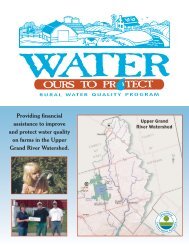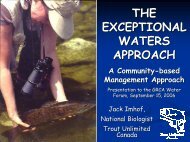Seeking serenity on the Grand - Grand River Conservation Authority
Seeking serenity on the Grand - Grand River Conservation Authority
Seeking serenity on the Grand - Grand River Conservation Authority
You also want an ePaper? Increase the reach of your titles
YUMPU automatically turns print PDFs into web optimized ePapers that Google loves.
THE GRAND STRATEGY NEWSLETTER Volume 15, Number 1 - Jan/Feb 2010<br />
<strong>Grand</strong> <strong>River</strong><br />
C<strong>on</strong>servati<strong>on</strong><br />
<strong>Authority</strong><br />
The <strong>Grand</strong>:<br />
A Canadian<br />
Heritage <strong>River</strong><br />
Features<br />
Canoeing <strong>the</strong> <strong>Grand</strong> 1<br />
Flooding since 1974 3<br />
UN forestry c<strong>on</strong>gress 5<br />
ATVers damage park 5<br />
Look Who’s<br />
Taking Acti<strong>on</strong><br />
<str<strong>on</strong>g>Seeking</str<strong>on</strong>g> <str<strong>on</strong>g>serenity</str<strong>on</strong>g> <strong>on</strong> <strong>the</strong> <strong>Grand</strong><br />
A patch of wisdom 7<br />
Trout Unlimited 8<br />
Elora bench program 8<br />
What's Happening<br />
Pollinator parks 9<br />
Trees as shelterbelts 10<br />
Rose is <strong>Grand</strong> artist 10<br />
Osprey returning 11<br />
<strong>Grand</strong> Strategy<br />
Calendar 12<br />
Cover photo:<br />
Hardy paddlers <strong>on</strong> New<br />
Year’s Day paddle to<br />
Glen Morris.<br />
Photo by Tom Harman<br />
By Janet Baine<br />
GRCA Communicati<strong>on</strong>s Specialist<br />
Urbanizati<strong>on</strong> intrudes surprisingly seldom<br />
during a canoe trip down <strong>the</strong> central <strong>Grand</strong><br />
<strong>River</strong>.<br />
There are far-off traffic noises and buildings<br />
or hydro lines sometimes peek through <strong>the</strong> forest.<br />
A piece of garbage occasi<strong>on</strong>ally hints that<br />
thoughtless people have been nearby. With a little<br />
imaginati<strong>on</strong>, it feels as if <strong>the</strong> <strong>Grand</strong> <strong>River</strong> is hidden<br />
deep in Canada’s wilderness and bel<strong>on</strong>gs to<br />
<strong>the</strong> her<strong>on</strong>, <strong>the</strong> swallows, <strong>the</strong> wind and me.<br />
On Tuesday evenings and some weekends<br />
starting last May, I paddled most of <strong>the</strong> <strong>Grand</strong><br />
<strong>River</strong> to Port Maitland <strong>on</strong> Lake Erie. I joined <strong>the</strong><br />
Waterloo Wellingt<strong>on</strong> Canoe Club part way<br />
through <strong>the</strong>ir summer odyssey of paddling <strong>the</strong><br />
entire 300-km <strong>Grand</strong> <strong>River</strong> from start to finish.<br />
This is <strong>the</strong> sec<strong>on</strong>d time <strong>the</strong> club has undertaken<br />
<strong>the</strong> entire <strong>Grand</strong> <strong>River</strong> in <strong>on</strong>e seas<strong>on</strong>. They called<br />
it GREEN 2009 (<strong>Grand</strong> <strong>River</strong> End-to-End<br />
Navigati<strong>on</strong>). I missed <strong>the</strong> early spring paddles at<br />
<strong>the</strong> headwaters. As many have before me, I discovered<br />
a perfect recreati<strong>on</strong>al opportunity very<br />
close at hand. It brought tranquility, fun, fresh air<br />
and friendship.<br />
I had spent years planning to canoe <strong>the</strong> <strong>Grand</strong><br />
<strong>River</strong>, and summers came and summers went<br />
with <strong>on</strong>ly <strong>on</strong>e excursi<strong>on</strong> between Cambridge and<br />
Paris.<br />
In c<strong>on</strong>trast, <strong>the</strong> canoe club offered a paddling<br />
opportunities <strong>on</strong>ce or twice a week that took<br />
place with or without any given club member. I<br />
made sure I took part in as many of <strong>the</strong> 19<br />
GREEN paddles as I could. Some co-workers<br />
joined me <strong>on</strong> occasi<strong>on</strong>.<br />
I didn’t have a canoe and n<strong>on</strong>e of my family<br />
share my interest. But <strong>the</strong> club provided compani<strong>on</strong>s<br />
who generously shared <strong>the</strong>ir expertise and<br />
found a spot for me in <strong>the</strong>ir boats. Now I have<br />
my own kayak, as club members use both canoes<br />
and kayaks.<br />
Four club members — Paul Kostiuk, Barb<br />
Davenport, Kathleen Vanessa Hyland and Tom<br />
Harman — paddled <strong>the</strong> entire river in 2009. But<br />
<strong>on</strong> any given secti<strong>on</strong>, six to nine boats would be<br />
unloaded for <strong>the</strong> GREEN paddles.<br />
Until <strong>the</strong> dizzying sou<strong>the</strong>rn porti<strong>on</strong> of <strong>the</strong>
iver, where watching for waves from<br />
speed boats was a challenge, <strong>the</strong> <strong>Grand</strong><br />
was relatively unhindered by recreati<strong>on</strong>al<br />
users. Some secti<strong>on</strong>s are <strong>on</strong>ly accessible<br />
by canoe.<br />
Dedicated fishermen are <strong>the</strong> most<br />
comm<strong>on</strong>ly seen recreati<strong>on</strong>al users. They<br />
wade into <strong>the</strong> shallow waters, while hikers<br />
and cyclists use <strong>the</strong> riverside trails.<br />
The 275-km <strong>Grand</strong> Valley Trail and<br />
o<strong>the</strong>r trails runs beside <strong>the</strong> river, but I<br />
have yet to see more that <strong>on</strong>e or two<br />
hikers out for an evening stroll, even in<br />
<strong>the</strong> most heavily populated areas. I know<br />
a great deal of credit for this recreati<strong>on</strong>al<br />
resource in <strong>the</strong> midst of a heavily populated<br />
area goes to <strong>the</strong> river’s natural<br />
volatility when it comes to flooding<br />
because policies keep buildings away<br />
form <strong>the</strong> river’s edge.<br />
With military precisi<strong>on</strong> <strong>the</strong> canoe<br />
club organized shuttles at put-ins and<br />
take-outs that divided <strong>the</strong> river into short<br />
stretches. The wet wea<strong>the</strong>r of 2009 cooperated,<br />
because <strong>the</strong> biggest challenge<br />
of paddling <strong>the</strong> <strong>Grand</strong> is ensuring that<br />
<strong>the</strong>re is enough water for a boat to move<br />
freely up<strong>on</strong> <strong>the</strong> surface. But never be<br />
fooled: <strong>the</strong> river can overturn paddlers<br />
who are not <strong>on</strong> <strong>the</strong> look out for an unexpected<br />
bend or rock.<br />
Now I am transformed from an occasi<strong>on</strong>al<br />
flat-water paddler into a canoeing<br />
enthusiast.<br />
After spending my days writing about<br />
river management and restorati<strong>on</strong>, it is<br />
fabulous to get out and simply enjoy <strong>the</strong><br />
river’s calming beauty. Even though <strong>the</strong><br />
<strong>Grand</strong> <strong>River</strong> and its tributaries are used<br />
and often abused, <strong>the</strong>y cleanse <strong>the</strong> soul<br />
and are a reminder of <strong>the</strong> value of keeping<br />
our natural envir<strong>on</strong>ment clean.<br />
For more informati<strong>on</strong>:<br />
E-mail: wwccpresident@yahoo.ca or<br />
Ph<strong>on</strong>e: 519-824-3824.<br />
Website:<br />
www.waterloowellingt<strong>on</strong>canoeclub.ca<br />
The club welcomes new members.<br />
More reflecti<strong>on</strong>s <strong>on</strong><br />
19 GREEN paddles<br />
By Barb Davenport<br />
Early in <strong>the</strong> spring with snow still <strong>on</strong><br />
<strong>the</strong> ground, a small group of hardy<br />
paddlers met at <strong>the</strong> <strong>Grand</strong> <strong>River</strong> headwaters.<br />
The air was crisp. I’m sure <strong>the</strong> locals<br />
were w<strong>on</strong>dering who <strong>the</strong>se strange looking<br />
people were dressed up in toques,<br />
wet suits, winter coats and heavy winter<br />
boots standing around a bunch of<br />
canoes. GREEN 2009 paddles had<br />
begun. At this point, <strong>the</strong> <strong>Grand</strong> <strong>River</strong> is<br />
<strong>on</strong>ly less than ten feet wide and running<br />
through rural country.<br />
Over <strong>the</strong> course of all <strong>the</strong> paddles, I<br />
was struck by <strong>the</strong> diversity of this<br />
mighty river, from <strong>the</strong> <str<strong>on</strong>g>serenity</str<strong>on</strong>g> and pastoral<br />
beauty at <strong>the</strong> headwaters to <strong>the</strong><br />
chaos at <strong>the</strong> mouth. From little evidence<br />
of man’s interventi<strong>on</strong>s to seeing garbage<br />
everywhere and experiencing <strong>the</strong> effects<br />
of dams. From a small river to a river<br />
which felt more like a lake. From being<br />
<strong>on</strong>e with nature to sharing <strong>the</strong> river with<br />
speed boats, sail boats, fishermen and<br />
water skiers. We saw more wildlife <strong>on</strong><br />
this river than what we’ve seen <strong>on</strong><br />
remote rivers.<br />
Three hundred kilometres, 5 m<strong>on</strong>ths,<br />
19 paddles and 50 hours later, <strong>the</strong> last<br />
official GREEN paddle finished. We<br />
enjoyed some great meals at local<br />
restaurants with stops for ice cream.<br />
Al<strong>on</strong>g <strong>the</strong> way, we had lots of laughs,<br />
had a few aquatic misadventures,<br />
enjoyed some amazing stories and accumulated<br />
a huge volume of pictures.<br />
Barb Davenport is <strong>the</strong> president of<br />
<strong>the</strong> Waterloo Wellingt<strong>on</strong> Canoe Club.<br />
<strong>Grand</strong> <strong>River</strong> photos from top:<br />
Portaging across <strong>the</strong> top of <strong>the</strong> Shand<br />
Dam; between Blair and <strong>the</strong><br />
Cambridge GTO; put-in at Templin<br />
Gardens, Fergus; harnessing a tail<br />
wind in <strong>the</strong> sou<strong>the</strong>rn <strong>Grand</strong> <strong>River</strong> en<br />
route to Byng Island; arriving at Port<br />
Maitland where <strong>the</strong> river enters Lake<br />
Erie.<br />
2<br />
Share <strong>the</strong> resources - Share <strong>the</strong> resp<strong>on</strong>sibility
Less<strong>on</strong>s learned after ’74 flood<br />
Coming through a culvert south of <strong>on</strong><br />
<strong>the</strong> nor<strong>the</strong>rn <strong>Grand</strong> <strong>River</strong><br />
Photo by Judy Luffman<br />
Three <strong>Grand</strong> clubs<br />
for canoeing seniors<br />
If you are over 55 and available during<br />
<strong>the</strong> day, you have many opportunities<br />
to join a canoe club.<br />
All three are based in different cities.<br />
They are associated with local seniors<br />
clubs. The clubs provide equipment such<br />
as canoes and paddles.<br />
The clubs in Cambridge and Waterloo<br />
are well established and sometimes have<br />
a waiting list for members in order to<br />
ensure that all receive training. The<br />
Guelph club in its sec<strong>on</strong>d year.<br />
All three feature regular outings <strong>on</strong><br />
<strong>the</strong> <strong>Grand</strong> <strong>River</strong> and elsewhere, training,<br />
and o<strong>the</strong>r activities.<br />
The Ancient Mariners, Cambridge:<br />
Website: www.ancientmariners.ca<br />
Ph<strong>on</strong>e: 519-748-5386<br />
E-Mail: wbellinger@primus.ca<br />
Old Salts Seniors Canoe Club,<br />
Waterloo:<br />
Membership meeting:, Feb. 18 at<br />
1 p.m. at Wing 404, 510 Dutt<strong>on</strong> Dr.,<br />
Waterloo.<br />
Ph<strong>on</strong>e: 519-888-7565<br />
E-mail: oldsalts@gmail.ca<br />
The Evergreen Canoe Club,<br />
Guelph<br />
Ph<strong>on</strong>e: 519-824-3336 or<br />
519-822-5789<br />
Fur<strong>the</strong>r informati<strong>on</strong>: Paddling <strong>the</strong><br />
<strong>Grand</strong> <strong>River</strong>, published 2006, available<br />
in bookstores and through <strong>the</strong> GRCA<br />
website. Or, check <strong>the</strong> Canoeing secti<strong>on</strong><br />
of www.grandriver.ca.<br />
This is <strong>on</strong>e of a series of articles<br />
about <strong>the</strong> history of <strong>the</strong> GRCA, which<br />
was formed in 1934 and recently celebrated<br />
its 75th anniversary.<br />
By Janet Baine<br />
GRCA Communicati<strong>on</strong>s Specialist<br />
Recent flooding in <strong>the</strong> <strong>Grand</strong> <strong>River</strong><br />
watershed would have been much<br />
more serious if it were not for <strong>the</strong> havoc<br />
wrought by <strong>the</strong> memorable flood of<br />
1974.<br />
That flood was a defining moment in<br />
<strong>the</strong> history of <strong>the</strong> <strong>Grand</strong> <strong>River</strong>. It resulted<br />
in numerous changes that have<br />
reduced <strong>the</strong> risk of flooding to people<br />
and property.<br />
May 17, 1974, started out sunny and<br />
warm. It deceived people who were<br />
“unaware of <strong>the</strong> approaching catastrophe,”<br />
according to Judge W.W. Leach,<br />
who presided over a provincial inquiry<br />
into that flood.<br />
When <strong>the</strong> rain came, <strong>the</strong>re was little<br />
that could be d<strong>on</strong>e, because <strong>the</strong> GRCA’s<br />
reservoirs were already full. According<br />
to <strong>the</strong> inquiry, warnings were sent, but<br />
<strong>the</strong>y didn’t get through to every<strong>on</strong>e<br />
affected.<br />
By 7 p.m. <strong>on</strong> May 17, <strong>the</strong> <strong>Grand</strong> was<br />
rushing through downtown Galt at a rate<br />
of 1,490 cubic metres per sec<strong>on</strong>d (m3/s),<br />
a record flow that has yet to be surpassed.<br />
The summer low flow is <strong>on</strong>ly 15<br />
m3/s.<br />
Dikes gave way in Bridgeport and<br />
Brantford. For<br />
a time, <strong>the</strong><br />
Brantford water<br />
treatment plant<br />
was knocked<br />
out of commissi<strong>on</strong>,<br />
creating a<br />
state of emergency.<br />
Floodwaters also engulfed parts of Paris,<br />
Caled<strong>on</strong>ia, Cayuga and Dunnville. All<br />
told, damages amounted to more than<br />
$6.9 milli<strong>on</strong> ($29 milli<strong>on</strong> in today’s dollars),<br />
excluding cleanup costs.<br />
‘Apathy’ about floods<br />
This flood left so many questi<strong>on</strong>s that<br />
<strong>the</strong> provincial inquiry into it went <strong>on</strong> for<br />
A February thaw in 2009 brought <strong>the</strong> <strong>Grand</strong> <strong>River</strong> into this neighbourhood in<br />
Cayuga. To see more recent flooding pictures, check <strong>the</strong> grandriverca page <strong>on</strong><br />
youtube.ca.<br />
GRAND ACTIONS • January/February 2010 3
Through flood damages have been reduced, some parts of <strong>the</strong> watershed are still<br />
susceptible to flooding, such as New Hamburg. Photo above was taken after a 1975<br />
flood. Flooding is <strong>the</strong> leading cause of public emergencies in Ontario today.<br />
m<strong>on</strong>ths. Judge Leach found that “in<br />
1974 <strong>the</strong>re was apathy throughout <strong>the</strong><br />
watershed, not <strong>on</strong>ly am<strong>on</strong>g <strong>the</strong> endangered,<br />
but in municipal governments<br />
and, to some extent, in <strong>the</strong> GRCA.”<br />
He called for a better flood warning<br />
system to be tested annually. He proposed<br />
improvements in <strong>the</strong> reservoir network.<br />
He urged <strong>the</strong> development of a<br />
computer simulati<strong>on</strong> model for <strong>the</strong> river.<br />
And he called <strong>on</strong> governments to buy<br />
more land and fur<strong>the</strong>r c<strong>on</strong>trol development<br />
in <strong>the</strong> flood plain to reduce future<br />
damages.<br />
Even with all of that in place, Judge<br />
Leach pointed out that <strong>the</strong> threat of<br />
flooding would never disappear.<br />
“The potential exists for very serious<br />
flooding in <strong>the</strong> watershed in <strong>the</strong> future,<br />
with real danger of loss of life and<br />
extensive property damage.”<br />
Since <strong>the</strong>n, $43 milli<strong>on</strong> has been<br />
spent <strong>on</strong> new dikes and flood protecti<strong>on</strong><br />
work in Brantford and Cambridge.<br />
Milli<strong>on</strong>s more have been invested in<br />
o<strong>the</strong>r communities.<br />
Over <strong>the</strong> years, <strong>the</strong> GRCA has finetuned<br />
<strong>the</strong> dam and reservoir system to<br />
hold water back and minimize flooding.<br />
Over <strong>the</strong> course of <strong>the</strong> last year, <strong>the</strong><br />
reservoirs prevented milli<strong>on</strong>s in damages<br />
for each of three separate events, but<br />
<strong>the</strong>re is no calculati<strong>on</strong> of <strong>the</strong> savings.<br />
The sudden mid-winter thaw <strong>on</strong> Dec.<br />
28, 2008 and <strong>the</strong> ensuing flooding<br />
showed how flood damages were averted.<br />
The flooding could have been a lot<br />
worse if <strong>the</strong> reservoirs in <strong>the</strong> system<br />
hadn’t been nearly empty, said Dwight<br />
Boyd, Senior Water Resources Engineer<br />
at <strong>the</strong> GRCA.<br />
At <strong>the</strong> time of <strong>the</strong> flood, <strong>the</strong> reservoirs<br />
were at <strong>the</strong>ir normal winter holding<br />
level, but <strong>the</strong>y filled up quickly because<br />
<strong>the</strong> sudden warm temperatures caused<br />
<strong>the</strong> snow to melt rapidly as rain pelted<br />
down. The combinati<strong>on</strong> of snowmelt and<br />
rain was equivalent to rainfall of 110<br />
mm to 215 mm (about 4.5 to 8.5 inches),<br />
Boyd said.<br />
The reservoir system cut flood peaks<br />
by 40 to 80 per cent <strong>on</strong> <strong>the</strong> rivers and<br />
streams where <strong>the</strong>re are reservoirs, o<strong>the</strong>rwise<br />
<strong>the</strong>y would have exceeded <strong>the</strong><br />
levels set during <strong>the</strong> 1974 flood in some<br />
areas.<br />
There would have been extensive<br />
flooding in St. Jacobs <strong>on</strong> <strong>the</strong> C<strong>on</strong>estogo<br />
<strong>River</strong>. In Brantford, water would have<br />
been close to <strong>the</strong> top of dikes c<strong>on</strong>structed<br />
after <strong>the</strong> 1974 flood. In Haldimand,<br />
water would have inundated porti<strong>on</strong>s of<br />
Caled<strong>on</strong>ia, Cayuga and Dunnville.<br />
The flood warning system is crucial<br />
to reducing <strong>the</strong> risk of flooding. This<br />
includes m<strong>on</strong>itoring <strong>the</strong> temperature,<br />
rain, snow and river levels. Wea<strong>the</strong>r<br />
radar informati<strong>on</strong> has recently been integrated<br />
into this system to help make<br />
flood forecasting as accurate as possible.<br />
Always <strong>on</strong> call<br />
A GRCA staff member is <strong>on</strong> call at<br />
all times and is alerted of any unusual<br />
increase in river levels, and <strong>the</strong>se staff<br />
members meet weekly.<br />
This warning system is especially<br />
important during <strong>the</strong> era of climate<br />
change, because severe wea<strong>the</strong>r systems<br />
may increase <strong>the</strong> potential for flooding,<br />
especially in localized areas. Real-time<br />
streamflow informati<strong>on</strong> has been in<br />
place since 1989 and most of this informati<strong>on</strong><br />
has been available in <strong>the</strong> <strong>River</strong><br />
Data secti<strong>on</strong> of www.grandriver.ca since<br />
2000.<br />
When flooding is possible, messages<br />
are sent to municipal flood coordinators,<br />
who are senior municipal staff, such as<br />
fire chiefs and public works managers.<br />
They can mobilize <strong>the</strong> emergency<br />
resp<strong>on</strong>se within <strong>the</strong>ir local community.<br />
The police and <strong>the</strong> media also receive<br />
<strong>the</strong>se messages and help to let people<br />
know if <strong>the</strong>y will be affected.<br />
This flood warning system has been<br />
tested each year since 1976, just as<br />
Judge Leach recommended. After <strong>the</strong><br />
test, <strong>the</strong> flood coordinators meet at <strong>the</strong><br />
GRCA usually in February, to talk about<br />
<strong>the</strong> flood outlook for <strong>the</strong> coming year.<br />
$1 billi<strong>on</strong> flood infrastructure<br />
The province has about $3 billi<strong>on</strong>worth<br />
of flood infrastructure and nearly<br />
a third of this is in <strong>the</strong> <strong>Grand</strong> <strong>River</strong><br />
watershed.<br />
4<br />
Share <strong>the</strong> resources - Share <strong>the</strong> resp<strong>on</strong>sibility
GRCA at UN’s World Forestry C<strong>on</strong>gress<br />
It was an eye opener for <strong>the</strong> GRCA’s<br />
Martin Neumann to talk about forestry<br />
in <strong>the</strong> <strong>Grand</strong> <strong>River</strong> watershed at <strong>the</strong><br />
United Nati<strong>on</strong>’s World Forestry<br />
C<strong>on</strong>gress in Buenos Aires in October.<br />
This event takes place every six years<br />
and it attracted 7,500 people from 160<br />
countries.<br />
Neumann, supervisor of terrestrial<br />
resources, spoke about “Forest and<br />
Water working toge<strong>the</strong>r:<br />
a 75 year success<br />
story.”<br />
During his presentati<strong>on</strong>,<br />
he was asked<br />
how a forester can<br />
c<strong>on</strong>sult a hydrologist<br />
or o<strong>the</strong>r experts with<br />
such ease in <strong>the</strong> <strong>Grand</strong><br />
<strong>River</strong> watershed. Martin Neumann<br />
“It is a real tribute to <strong>the</strong> way our<br />
organizati<strong>on</strong> works. C<strong>on</strong>servati<strong>on</strong><br />
authorities are unique and <strong>the</strong>re are no<br />
barriers between different disciplines<br />
because we all work toge<strong>the</strong>r under <strong>on</strong>e<br />
roof,” Neumann said. He realized while<br />
attending this event how easy it is to<br />
lose sight of how Ontario’s 36 c<strong>on</strong>servati<strong>on</strong><br />
authorities stand out as collaborative<br />
organizati<strong>on</strong>s in <strong>the</strong> world of c<strong>on</strong>-<br />
servati<strong>on</strong> management.<br />
Key challenge of our time<br />
The UN c<strong>on</strong>siders a key challenge of<br />
our time to be <strong>the</strong> difficulty in bringing<br />
people toge<strong>the</strong>r from different disciplines<br />
and jurisdicti<strong>on</strong>s to work <strong>on</strong><br />
forestry and hydrology. C<strong>on</strong>servati<strong>on</strong><br />
authorities encourage inter-disciplinary<br />
and cross-jurisdicti<strong>on</strong>al collaborati<strong>on</strong> for<br />
watershed health.<br />
Neumann’s talk described <strong>the</strong> way <strong>the</strong><br />
GRCA also undertakes forestry projects<br />
with partner organizati<strong>on</strong>s. An example<br />
he gave was <strong>the</strong> Guelph Rotary Forest<br />
project near Guelph Lake. The Guelph<br />
Rotary Club has taken <strong>on</strong> <strong>the</strong> challenge<br />
of organizing an annual event to plant<br />
trees each spring over a dozen years<br />
with assistance from <strong>the</strong> GRCA and<br />
o<strong>the</strong>r organizati<strong>on</strong>s. Eventually, a 40-<br />
hectare field will be turned into a forest.<br />
A fellow panelist from Australia was<br />
very interested in undertaking a similar<br />
project in his own country.<br />
“Some of <strong>the</strong> things that we do here<br />
can be easily transferred to o<strong>the</strong>r locati<strong>on</strong>s,”<br />
Neumann said.<br />
This UN c<strong>on</strong>gress was part of <strong>the</strong><br />
preparati<strong>on</strong> for <strong>the</strong> Copenhagen Climate<br />
It is a challenge to get people from different jurisdicti<strong>on</strong>s and disciplines working<br />
toge<strong>the</strong>r to improve watershed health.This is a reforestati<strong>on</strong> project in Argentina that<br />
will help improve water quality.<br />
Change summit in December due to <strong>the</strong><br />
c<strong>on</strong>necti<strong>on</strong> between <strong>the</strong> worldwide problem<br />
of deforestati<strong>on</strong> and climate change.<br />
Diversity and naturalizati<strong>on</strong> are key<br />
features of plantati<strong>on</strong> forests that are<br />
being undertaken in <strong>the</strong> <strong>Grand</strong> <strong>River</strong><br />
watershed. But in most of <strong>the</strong> developing<br />
world, plantati<strong>on</strong> forests are very<br />
large with ei<strong>the</strong>r <strong>on</strong>e species of pine or<br />
eucalyptus. These m<strong>on</strong>oculture plantati<strong>on</strong>s<br />
play a role in taking pressure off<br />
natural forests, because <strong>the</strong>y are used for<br />
<strong>the</strong> products <strong>the</strong>y produce. But <strong>the</strong>y are<br />
not very resilient and <strong>the</strong>y d<strong>on</strong>’t encourage<br />
biodiversity.<br />
In c<strong>on</strong>trast, most private landowners<br />
within our watershed who plant trees are<br />
interested in creating wildlife habitat,<br />
and are often less interested in timber<br />
producti<strong>on</strong> — a luxury that o<strong>the</strong>r parts<br />
of <strong>the</strong> world may not have.<br />
Forests and water are two of <strong>the</strong> key<br />
global envir<strong>on</strong>mental challenges of this<br />
century, and <strong>the</strong>ir increasing scarcity<br />
affects <strong>the</strong> quality and even <strong>the</strong> viability<br />
of life for milli<strong>on</strong>s around <strong>the</strong> world.<br />
Imagine if <strong>the</strong> c<strong>on</strong>servati<strong>on</strong> authority<br />
model holds <strong>on</strong>e of <strong>the</strong> keys, in some<br />
small way, to meet those challenges,<br />
Neumann says.<br />
ATVs a big problem<br />
at C<strong>on</strong>estogo Lake<br />
By Dave Schultz<br />
GRCA Communicati<strong>on</strong>s Manager<br />
Every year, Dean McFadden welcomes<br />
tens of thousands of people<br />
to C<strong>on</strong>estogo Lake C<strong>on</strong>servati<strong>on</strong> Area,<br />
where he’s been park superintendent for<br />
9 years.<br />
Campers, swimmers, boaters, anglers,<br />
cottagers, hikers, picnickers, hunters and<br />
o<strong>the</strong>rs enjoy <strong>the</strong> natural setting and<br />
amenities of <strong>the</strong> Drayt<strong>on</strong>-area park,<br />
owned by <strong>the</strong> <strong>Grand</strong> <strong>River</strong> C<strong>on</strong>servati<strong>on</strong><br />
<strong>Authority</strong>. They come in through <strong>the</strong><br />
gate, pay fees and use <strong>the</strong> facilities provided<br />
for <strong>the</strong>m.<br />
But <strong>the</strong>re’s <strong>on</strong>e group that isn’t welcome<br />
at C<strong>on</strong>estogo Lake — off-roaders.<br />
Whe<strong>the</strong>r <strong>the</strong>y’re driving small all-ter-<br />
GRAND ACTIONS • January/February 2010 5
Dean McFadden C<strong>on</strong>estogo Lake c<strong>on</strong>servati<strong>on</strong> area superintendent shows a spot<br />
where off-roaders have torn out a sign before going <strong>on</strong> to damage a natural area.<br />
rain vehicles (ATVs) or large fourwheel-drive<br />
pickups, <strong>the</strong>y literally leave<br />
a trail of destructi<strong>on</strong>. They’re trespassing<br />
and paying nothing to <strong>the</strong> upkeep of <strong>the</strong><br />
c<strong>on</strong>servati<strong>on</strong> area.<br />
They show up each fall when <strong>the</strong><br />
water level in <strong>the</strong> C<strong>on</strong>estogo Lake reservoir<br />
drops down to its winter holding<br />
level and will be <strong>the</strong>re almost daily until<br />
<strong>the</strong> snow flies. Then <strong>the</strong>y’re back in <strong>the</strong><br />
spring until <strong>the</strong> reservoir is refilled.<br />
Many will tear through <strong>the</strong> woods <strong>on</strong><br />
<strong>the</strong>ir way to <strong>the</strong> reservoir bottom where<br />
<strong>the</strong>y spin doughnuts in <strong>the</strong> mud flats. To<br />
get <strong>the</strong>re, <strong>the</strong>y’ll run around gates, over<br />
torn-down fences and right past “No<br />
ATV” signs posted throughout <strong>the</strong> property.<br />
Signs disappear, fences cut<br />
The signs disappear regularly. Fences<br />
are cut down. Barriers built out of fallen<br />
trees have been cut into pieces and<br />
tossed out of <strong>the</strong> way.<br />
McFadden estimates he spends about<br />
$1,000 a year replacing signs and<br />
fences. That’s m<strong>on</strong>ey that comes directly<br />
out of park revenues, since no tax dollars<br />
are used to maintain <strong>the</strong> property.<br />
And that doesn’t even begin to<br />
account for <strong>the</strong> envir<strong>on</strong>mental damage<br />
d<strong>on</strong>e by <strong>the</strong> four-wheelers that create big<br />
ruts, erode hillsides and leave behind<br />
assorted garbage, including liquor bottles.<br />
It’s all very frustrating for McFadden<br />
who is <strong>on</strong>e of just two full-time employees<br />
working year-round to maintain <strong>the</strong><br />
2,300 hectare property. About half of <strong>the</strong><br />
property is forest and most of it is riddled<br />
with illegal trails.<br />
“They’re riding right past <strong>the</strong> signs,<br />
so <strong>the</strong>y know <strong>the</strong>y’re not supposed to be<br />
<strong>the</strong>re,” McFadden said while touring <strong>the</strong><br />
property recently. “It’s a huge property<br />
and it’s impossible to fence it all. But<br />
<strong>the</strong>y just cut through <strong>the</strong> fences anyway.”<br />
It’s not <strong>on</strong>ly destructive, it’s illegal.<br />
Provincial law prohibits off-road vehicles<br />
from c<strong>on</strong>servati<strong>on</strong> authority lands.<br />
On top of that, <strong>the</strong>y’re trespassing <strong>on</strong><br />
GRCA land because <strong>the</strong>y’re entering <strong>the</strong><br />
property through makeshift entrances<br />
while <strong>the</strong> park is closed.<br />
Every fall, McFadden, assistant<br />
superintendent Mike Stanwyck and o<strong>the</strong>r<br />
GRCA staff, spend many hours<br />
patrolling <strong>the</strong> property, looking for trespassing<br />
four-wheelers and repairing <strong>the</strong>ir<br />
damage. Steel warning signs have a life<br />
expectancy of a few days, and plastic<br />
<strong>on</strong>es can disappear in hours. He’s had to<br />
replace gates at $450 a shot and place<br />
large c<strong>on</strong>crete blocks at trail entrances.<br />
But, more often than not, <strong>the</strong> ATV riders<br />
just carve out a new entrance a few<br />
metres away.<br />
A first offender may get a warning<br />
or a $70 ticket. Although he hasn’t d<strong>on</strong>e<br />
it yet, McFadden could take a repeat<br />
offender to court where <strong>the</strong> fines could<br />
run $2,000 or more.<br />
When Wellingt<strong>on</strong> County OPP spot a<br />
trespasser <strong>the</strong>y may hold him until<br />
McFadden arrives to issue a ticket.<br />
He knows some ATVers are locals but<br />
o<strong>the</strong>rs come from miles around. He’s<br />
ticketed trespassers from Palmerst<strong>on</strong> and<br />
Kitchener who will bring <strong>the</strong>ir ATVs to<br />
<strong>the</strong> park aboard a trailer.<br />
McFadden said <strong>on</strong>e comm<strong>on</strong> misc<strong>on</strong>cepti<strong>on</strong><br />
is that C<strong>on</strong>estogo Lake<br />
C<strong>on</strong>servati<strong>on</strong> Area is “Crown land” but<br />
that’s just wr<strong>on</strong>g.<br />
“Anyway, even if it were Crown land,<br />
that doesn’t give <strong>the</strong>m <strong>the</strong> right to come<br />
in and wreck it,” he says.<br />
The ATVers are causing problems for<br />
o<strong>the</strong>r park users, as well. Each fall about<br />
200 hunters buy permits to hunt pheasants,<br />
waterfowl and small game. A<br />
hunter may spend a lot of time in a tree<br />
or a c<strong>on</strong>cealed area waiting for game to<br />
come his way, <strong>on</strong>ly to have <strong>the</strong> quiet<br />
destroyed by a speeding ATV.<br />
Large ruts <strong>on</strong> a trail are part of <strong>the</strong><br />
damage left by off-roaders.<br />
6<br />
Share <strong>the</strong> resources - Share <strong>the</strong> resp<strong>on</strong>sibility
Cottage owners are also annoyed by<br />
<strong>the</strong> c<strong>on</strong>stant noise and <strong>the</strong> damage to <strong>the</strong><br />
lakeside porti<strong>on</strong> of <strong>the</strong>ir lots, which <strong>the</strong>y<br />
lease from <strong>the</strong> GRCA. The GRCA has<br />
been working with cottagers to impress<br />
up<strong>on</strong> <strong>the</strong>m that <strong>the</strong>ir leases forbid <strong>the</strong>m<br />
from using ATVs in <strong>the</strong> c<strong>on</strong>servati<strong>on</strong><br />
area outside of <strong>the</strong>ir own lots.<br />
The ATVs also ruin snowmobile trails<br />
which are carefully maintained by members<br />
of local clubs who have a lease<br />
with <strong>the</strong> GRCA and pay a fee to use<br />
<strong>the</strong>m. ATVs are not permitted in any<br />
seas<strong>on</strong> <strong>on</strong> trails maintained by <strong>the</strong><br />
Ontario Federati<strong>on</strong> of Snowmobile<br />
Clubs.<br />
ATV riders may even be putting <strong>the</strong>ir<br />
own lives at risk.<br />
“It’s a big property,” says McFadden.<br />
“If an accident happens, how can we<br />
find <strong>the</strong>m and rescue <strong>the</strong>m?”<br />
The ATV trails are often narrow and<br />
rutted, it would be next to impossible to<br />
get a rescue vehicle into <strong>the</strong> forest, he<br />
said.<br />
LOOK WHO’S<br />
TAKING ACTION<br />
A patch<br />
of wisdom<br />
By Valerie Fieldwebster<br />
Resource Interpreter<br />
During our visit to Newfoundland we<br />
were lucky to have our friends Dave<br />
Shepherd and Julie Cappleman to show<br />
us around.<br />
One evening, while sitting around a<br />
bottle of wine, Dave explained <strong>the</strong> c<strong>on</strong>cept<br />
of having a “patch.” Not surprisingly,<br />
a patch is a very British thing. It is<br />
simply your area of land. It is not something<br />
you own, but ra<strong>the</strong>r an area you<br />
watch. Having a patch means observing<br />
what is <strong>the</strong>re in all seas<strong>on</strong>s. Watching<br />
birds arrive and depart, and watching<br />
buds ripen and turn to fruit. When you<br />
have a patch you learn by observati<strong>on</strong><br />
and explorati<strong>on</strong>. Dave explained about a<br />
stray migrant petrel that had been spotted<br />
Valerie Fieldwebster at work documenting a species in <strong>the</strong> forest.<br />
<strong>on</strong> <strong>the</strong> coast of England. As <strong>the</strong> bird flew<br />
al<strong>on</strong>g <strong>the</strong> coast it was crossing over individual<br />
patches. The bird’s flight was well<br />
documented as each birder recorded it<br />
and alerted <strong>the</strong> birder in <strong>the</strong> next patch<br />
that this accidental visitor was heading<br />
<strong>the</strong>ir way. The beauty of having a patch is<br />
<strong>the</strong> depth of knowledge and understanding<br />
a pers<strong>on</strong> gains. Dave knew exactly<br />
where to take us to have <strong>the</strong> best chance<br />
of seeing Willow Ptarmigan or Caribou.<br />
Watching a patch develops a nurturing<br />
relati<strong>on</strong>ship between <strong>the</strong> observer and <strong>the</strong><br />
land. Any<strong>on</strong>e can enjoy patch watching.<br />
No need for vacati<strong>on</strong> time, planes or l<strong>on</strong>g<br />
car rides, just steal some time out of your<br />
busy day and make a short visit to your<br />
local patch.<br />
Today, <strong>on</strong> my way home from a challenging<br />
day at work, I passed <strong>the</strong> cranberry<br />
marsh which I might call my patch.<br />
I stopped <strong>the</strong> car and put <strong>on</strong> my boots<br />
and went for a hike. Not far al<strong>on</strong>g, my<br />
way was blocked by a large black willow<br />
that had fallen across <strong>the</strong> trail. I remembered<br />
that it had been in ill health and<br />
last year <strong>the</strong>re had been a cavity nest in<br />
<strong>the</strong> trunk. The trail was not in very good<br />
shape, <strong>the</strong>re being large burdock plants<br />
growing all over it. I had to pick my way<br />
carefully in order not to pick up any of<br />
<strong>the</strong>se Velcro-like friends. Inside almost<br />
every <strong>on</strong>e of those burrs is a weevil,<br />
waiting to emerge in <strong>the</strong> spring.<br />
Whatever bird eats burr weevils is going<br />
to have a great spring! Looking down, I<br />
saw racco<strong>on</strong> tracks in <strong>the</strong> snow, and I<br />
was reminded of a spring walk where I<br />
found a painted turtle shell. What luck I<br />
thought, but <strong>the</strong>n a couple of days later, I<br />
found ano<strong>the</strong>r turtle shell with part of <strong>the</strong><br />
turtle still in it. Then <strong>on</strong> a third outing,<br />
ano<strong>the</strong>r excavated shell. Very few animals<br />
can get at a mature painted turtle to<br />
eat it. It was those l<strong>on</strong>g fingers making<br />
tracks in <strong>the</strong> snow that identified <strong>the</strong> culprit.<br />
In total, last spring I found <strong>the</strong><br />
remains of four mature turtles eaten by<br />
<strong>the</strong> racco<strong>on</strong>. Sadly last spring I also<br />
found a beautiful Red Fox that had been<br />
hit and killed by a car. Strangely though,<br />
ano<strong>the</strong>r Red Fox came al<strong>on</strong>g and deposited<br />
scat <strong>on</strong> its head. What was that about?<br />
My patch is a dynamic place. I am<br />
anxious to see if <strong>the</strong> Great Horned Owl<br />
returns to nest this winter, how many turtles<br />
emerge from hibernati<strong>on</strong>, and who is<br />
going to eat all those burr weevils?<br />
So I invite you to take a walk in <strong>the</strong><br />
Vance Tract off Downy Road in Guelph.<br />
Or claim your own patch from <strong>on</strong>e of <strong>the</strong><br />
many rich natural heritage areas we have<br />
in <strong>the</strong> <strong>Grand</strong> <strong>River</strong> watershed.<br />
GRAND ACTIONS • January/February 2010 7
Naturalizing Marden Creek<br />
to bring back <strong>the</strong> brook trout<br />
By Janet Baine<br />
GRCA Communicati<strong>on</strong>s<br />
Trout Unlimited Canada’s Speed<br />
Valley Chapter received a 2009<br />
<strong>Grand</strong> <strong>River</strong> Watershed Award for <strong>the</strong>ir<br />
work with <strong>the</strong> Wellingt<strong>on</strong> County<br />
Stewardship Council in bringing brook<br />
trout back to Marden Creek, an important<br />
tributary of <strong>the</strong> Speed <strong>River</strong> at <strong>the</strong><br />
north end of Guelph.<br />
“Brook trout are special because <strong>the</strong>y<br />
require clean, clear cold water with lots<br />
of oxygen and that’s <strong>the</strong> way <strong>the</strong>se<br />
streams have been since <strong>the</strong> glaciers<br />
retreated. Brook trout are a good indicati<strong>on</strong><br />
that <strong>the</strong> streams are healthy. If<br />
brook trout are living <strong>the</strong>re, we know <strong>the</strong><br />
streams are doing well,” says chapter<br />
president Mike Emeneau.<br />
The group’s missi<strong>on</strong> is to work with<br />
landowners and o<strong>the</strong>r like-minded<br />
groups to preserve, enhance and c<strong>on</strong>serve<br />
coldwater habitats within <strong>the</strong><br />
Speed Valley watershed. The Speed<br />
Valley Chapter started four years ago<br />
and <strong>the</strong>y now have more than 50 mem-<br />
bers. They have been taking many steps<br />
to restore <strong>the</strong> creek which has been<br />
degraded over <strong>the</strong> last century due to<br />
deforestati<strong>on</strong>, intensive agriculture and<br />
nearby development.<br />
The chapter holds work days which<br />
attract 30 or 40 people who come to help<br />
deepen and narrow <strong>the</strong> stream — a<br />
wider stream warms and slows <strong>the</strong><br />
water. They’ve added deflectors to help<br />
maintain <strong>the</strong> banks and created pools<br />
and spawning areas to improve fish<br />
habitat. They have also taken some<br />
p<strong>on</strong>ds offline, so that <strong>the</strong> stream goes<br />
around <strong>the</strong> p<strong>on</strong>ds instead of through <strong>the</strong><br />
middle of <strong>the</strong>m. The water went into <strong>on</strong>e<br />
p<strong>on</strong>d at 17 degrees and left it at 27<br />
degrees, so that <strong>the</strong> trout could survive<br />
above <strong>the</strong> p<strong>on</strong>d, but not below it. After<br />
<strong>the</strong> changes, <strong>the</strong> temperature dropped.<br />
1993 Watershed award<br />
Trout Unlimited has 17 chapters in<br />
Ontario including two in <strong>the</strong> <strong>Grand</strong><br />
<strong>River</strong> watershed. The Middle <strong>Grand</strong><br />
<strong>River</strong> Chapter based in Brantford<br />
received a 1993 Watershed Award For<br />
Volunteers from <strong>the</strong> Speed Valley Chapter of Trout Unlimited Canada <strong>on</strong> a work day<br />
in Marden Creek..<br />
Photo by Larry Halyk<br />
Brook trout from Marden Creek.<br />
informati<strong>on</strong>, call Dave Chapman at 905-<br />
573-9017.<br />
To see a video about this work, check<br />
<strong>the</strong> Watershed Awards secti<strong>on</strong> of<br />
grandriver.ca. For more informati<strong>on</strong><br />
about <strong>the</strong> Speed Valley chapter call<br />
Mike Emeneau at 519-837-2507.<br />
Benches installed<br />
al<strong>on</strong>g Elora-Cataract<br />
Trailway<br />
F<br />
ive new benches have been placed<br />
al<strong>on</strong>g <strong>the</strong> Elora-Cataract Trailway<br />
and <strong>the</strong>re are plans to install four more<br />
this year.<br />
This is thanks to a program called<br />
Project BOOT (Benches On Our Trail)<br />
and it has been undertaken by <strong>the</strong> Elora<br />
Cataract Trailway Associati<strong>on</strong>, six local<br />
Li<strong>on</strong>s clubs, <strong>the</strong> GRCA and <strong>the</strong> Credit<br />
Valley C<strong>on</strong>servati<strong>on</strong> <strong>Authority</strong>.<br />
Each agency is resp<strong>on</strong>sible for porti<strong>on</strong>s<br />
of <strong>the</strong> initiative. The Li<strong>on</strong>s Clubs<br />
are selling, installing and maintaining<br />
<strong>the</strong> benches, which are $450. The six<br />
local Li<strong>on</strong>’s Clubs are Elora, Fergus,<br />
Belwood, Marsville, Hillsburgh and<br />
Erin.<br />
The Elora Cataract Trailway<br />
Associati<strong>on</strong> is a volunteer organizati<strong>on</strong><br />
that promotes and advocates for <strong>the</strong><br />
trailway. The former railway land is<br />
owned by <strong>the</strong> two c<strong>on</strong>servati<strong>on</strong> authorities.<br />
Any<strong>on</strong>e who is interested in c<strong>on</strong>tributing<br />
to <strong>the</strong> installati<strong>on</strong> of a bench<br />
should get in touch with <strong>the</strong>ir local<br />
Li<strong>on</strong>’s Club or Raym<strong>on</strong>d Soucy from<br />
ECTA at 519-843-7703.<br />
8<br />
Share <strong>the</strong> resources - Share <strong>the</strong> resp<strong>on</strong>sibility
Pollinati<strong>on</strong> Guelph plans to have several areas planted with pollinator-friendly<br />
plants in 2010. These will be examples of what people can do in <strong>the</strong>ir own yards.<br />
Guelph makes a beeline<br />
in c<strong>on</strong>servati<strong>on</strong><br />
By Victoria MacPhaill<br />
Pollinati<strong>on</strong> Guelph<br />
Did you know that Guelph will so<strong>on</strong><br />
be <strong>the</strong> home of <strong>the</strong> world’s first<br />
large-scale pollinati<strong>on</strong> park? That <strong>on</strong>e<br />
out of every three bites of food is a<br />
result of pollinators? That pollinators are<br />
in serious decline, but a lot can be d<strong>on</strong>e<br />
to help <strong>the</strong>m?<br />
Pollinati<strong>on</strong> takes place when pollen<br />
moves from <strong>on</strong>e part of a flower (<strong>the</strong><br />
an<strong>the</strong>rs) to ano<strong>the</strong>r (stigmas). This is<br />
d<strong>on</strong>e by birds, bats, insects, <strong>the</strong> wind, or<br />
rain. This transfer leads to fertilizati<strong>on</strong><br />
and successful seed and fruit producti<strong>on</strong>.<br />
Pollinators are <strong>the</strong> animals that pollinate<br />
over 90 per cent of all flowering<br />
plants, and primarily include bees, flies,<br />
butterflies, moths, and o<strong>the</strong>r insects,<br />
although birds, bats, and o<strong>the</strong>r animals<br />
can also pollinate. Toge<strong>the</strong>r <strong>the</strong>y are an<br />
indispensable natural resource, and <strong>the</strong>ir<br />
daily work is essential for over a billi<strong>on</strong><br />
dollars of apples, pears, cucumbers, mel<strong>on</strong>s,<br />
berries, and o<strong>the</strong>r farm produce.<br />
However, <strong>the</strong>se beneficial insects are<br />
under pressure from loss of habitat, loss<br />
of food sources, disease and pesticides.<br />
As important as pollinators are to agriculture<br />
and ecosystem health, surprisingly<br />
little is known about <strong>the</strong>ir status or<br />
how to reverse <strong>the</strong>ir decline.<br />
First big pollinator park<br />
Members of Pollinati<strong>on</strong> Guelph are<br />
dedicated to c<strong>on</strong>serving and developing<br />
pollinator habitat. The group promotes<br />
awareness of <strong>the</strong> role of pollinators in<br />
local and global envir<strong>on</strong>mental sustainability.<br />
It will showcase world class pollinator<br />
projects that are a model for citizens<br />
and communities throughout<br />
Canada and internati<strong>on</strong>ally.<br />
The initial project is 45 hectares (112<br />
acres) at <strong>the</strong> decommissi<strong>on</strong>ed Eastview<br />
landfill site <strong>on</strong> <strong>the</strong> nor<strong>the</strong>ast side of <strong>the</strong><br />
city. It is <strong>on</strong>e of <strong>the</strong> first and largest pollinator<br />
initiatives in Ontario, Canada,<br />
and internati<strong>on</strong>ally and highlights <strong>the</strong><br />
city’s commitment to <strong>the</strong> envir<strong>on</strong>ment.<br />
The park will increase public educati<strong>on</strong><br />
and participati<strong>on</strong>. People can <strong>the</strong>n<br />
take this knowledge and make <strong>the</strong>ir own<br />
pollinator-friendly areas, or support similar<br />
initiatives. Even now o<strong>the</strong>r communities<br />
are looking to Guelph as an example<br />
to follow.<br />
Like all animals, pollinators need<br />
food, water and shelter. Shelter in this<br />
case is nesting or egg-laying sites: hollow<br />
twigs, dead wood, underground<br />
holes, bare soil and <strong>the</strong> underside of<br />
plant leaves. Food is usually pollen (protein),<br />
nectar (energy) and, for some<br />
species, o<strong>the</strong>r plant tissues. The park<br />
will be designed to satisfy all <strong>the</strong>se<br />
needs, and <strong>the</strong>refore will be an ecological<br />
reserve, allowing populati<strong>on</strong>s to stabilize,<br />
increase, and <strong>the</strong>n disperse into<br />
adjoining areas.<br />
The park will also help more than just<br />
pollinators. For example, with more pollinators,<br />
<strong>the</strong>re will be more fruit and<br />
seeds produced which will, in turn,<br />
attract more birds and o<strong>the</strong>r animals.<br />
Research is already underway to<br />
m<strong>on</strong>itor <strong>the</strong> diversity and abundance of<br />
pollinators as <strong>the</strong> park develops and<br />
matures. Additi<strong>on</strong>al research projects<br />
will involve different methods of planting,<br />
species mixes, provisi<strong>on</strong> of pollinator<br />
nesting habitats, and much more.<br />
Pollinati<strong>on</strong> Guelph broke ground in<br />
2009 with a 1.5 hectare dem<strong>on</strong>strati<strong>on</strong><br />
plot. Some of <strong>the</strong> species for this meadow<br />
include black-eyed susans, c<strong>on</strong>eflowers,<br />
bee-balm, bergamot, tickseed, beardtounge,<br />
goldenrod, aster, gramma grasses,<br />
sporodropseed grasses, milkweeds<br />
and blazing star. We also hope to have a<br />
formal secti<strong>on</strong> with examples of garden<br />
plants, including fruit and vegetables<br />
that require pollinati<strong>on</strong>.<br />
To learn more, visit www.pollinati<strong>on</strong>guelph.ca.<br />
Details about a pollinati<strong>on</strong><br />
symposium <strong>on</strong> Saturday,March 27<br />
will also be posted <strong>the</strong>re.<br />
A pollinator park in Cambridge<br />
The Ancient Mariners Canoe Club is<br />
also a-buzz with plans for a pollinator<br />
park at <strong>River</strong>bluffs Park in Cambridge.<br />
Last year fences were removed and a<br />
former off-leash area was allowed to<br />
grow. Eventually, <strong>the</strong> club hopes to<br />
install benches, signs and trails.<br />
GRAND ACTIONS • January/February 2010 9
Trees: Growing shelterbelts in rural areas<br />
By Dallas Campbell<br />
Trees for Maplet<strong>on</strong><br />
Rural areas in <strong>the</strong> <strong>Grand</strong> <strong>River</strong> watershed<br />
are going to look very different<br />
in 15 years.<br />
In Maplet<strong>on</strong> al<strong>on</strong>e, residents planted<br />
40,000 trees last year. Those trees aren’t<br />
easy to spot right now, but <strong>the</strong>y are all<br />
around. With time, <strong>the</strong>y will grow to<br />
define rural property lines. The sides of<br />
creeks and rivers will slowly emerge<br />
into buffered corridors where plants and<br />
wildlife communities can flourish.<br />
Barns, houses and workshops will be<br />
surrounded by trees that will protect<br />
<strong>the</strong>m from <strong>the</strong> harsh winter winds.<br />
As any<strong>on</strong>e can tell you, heating<br />
means big bills throughout <strong>the</strong> winter.<br />
No matter how well a house, building or<br />
barn is insulated, <strong>the</strong> winds blow dollars<br />
out of your hands and into <strong>the</strong> bank<br />
accounts of propane and natural gas<br />
companies. Some of this hard w<strong>on</strong><br />
m<strong>on</strong>ey could remain with <strong>the</strong> rural property<br />
owner.<br />
Planting trees around <strong>the</strong> perimeter of<br />
a farm or rural property will increase<br />
crop yields by as much as 20 per cent<br />
over time. Many rural residents are<br />
already enjoying <strong>the</strong> benefits of well<br />
placed windbreaks that were planted 20<br />
or more years ago. Every spring many<br />
more windbreaks are being planted. The<br />
Trees for Maplet<strong>on</strong> program has focused<br />
a lot of time and effort <strong>on</strong> this style of<br />
These trees form a sheltebelt.<br />
tree planting and educati<strong>on</strong>, with plenty<br />
of success. What I propose to you now is<br />
<strong>the</strong> shelterbelt style of tree planting.<br />
The <strong>the</strong>ory behind shelterbelts is easy<br />
to explain. Basically, trees are planted<br />
around a farmstead to reduce <strong>the</strong> wind<br />
that hits <strong>the</strong> buildings. Less wind means<br />
less need for heat. In fact, <strong>the</strong> average<br />
farmstead heating bill in Maplet<strong>on</strong> can<br />
be reduced by as much as 27 per cent<br />
when trees are planted in <strong>the</strong> right<br />
places. Proper spacing between trees can<br />
be tricky. Wind directi<strong>on</strong> and species<br />
selecti<strong>on</strong> also need to be c<strong>on</strong>sidered.<br />
There are many reas<strong>on</strong>s to c<strong>on</strong>sider a<br />
shelterbelt tree planting project. If you<br />
own a rental property, your tenants will<br />
benefit from <strong>the</strong> reduced heating bills<br />
over time.<br />
Many reas<strong>on</strong>s for shelterbelts<br />
Properly placed trees in a dairy operati<strong>on</strong><br />
can help shade livestock and<br />
increase milk producti<strong>on</strong> through <strong>the</strong><br />
summer m<strong>on</strong>ths. Milk producti<strong>on</strong> starts<br />
to decline after temperatures of 20<br />
degrees are reached. Trees can be planted<br />
parallel to buildings so that <strong>the</strong>y d<strong>on</strong>’t<br />
take up too much space but still have <strong>the</strong><br />
desired effect. They also increase privacy.<br />
If you have issues with snow build<br />
up al<strong>on</strong>g laneways and turning areas,<br />
trees can help reduce <strong>the</strong> amount of<br />
work put into snow removal through <strong>the</strong><br />
winter. Less time behind <strong>the</strong> snow plow<br />
and more time for o<strong>the</strong>r important<br />
chores.<br />
These services are available throughout<br />
<strong>the</strong> <strong>Grand</strong> <strong>River</strong> watershed through<br />
<strong>the</strong> Rural Water Quality program. Staff<br />
can provide <strong>the</strong> technical assistance in<br />
developing a tree planting plan for a<br />
spring or fall project in 2010. Call so<strong>on</strong>,<br />
as trees are limited. C<strong>on</strong>sider how a<br />
shelterbelt planting can work for you <strong>on</strong><br />
your property.<br />
Call Tracey Ryan 519-621-2761 ext.<br />
2269 or e-mail her at<br />
tryan@grandriver.ca to be put in touch<br />
with <strong>the</strong> appropriate staff member.<br />
WHAT’S<br />
HAPPENING?<br />
<strong>Grand</strong> <strong>River</strong>:<br />
<strong>Grand</strong> C<strong>on</strong>versati<strong>on</strong>s<br />
Landscape and <strong>the</strong> <strong>Grand</strong> <strong>River</strong> will<br />
be <strong>the</strong> main feature in Stefan Rose’s<br />
work as <strong>the</strong> City of Kitchener artist-inresidence<br />
for 2010.<br />
Rose, a Waterloo artist, was appointed<br />
by city council in November. He has<br />
designed a program of photography,<br />
poetry and video to explore <strong>the</strong> effects<br />
of landscape and geography <strong>on</strong> people’s<br />
community-building experiences.<br />
The year-l<strong>on</strong>g program, entitled<br />
'’<strong>Grand</strong> <strong>River</strong>: <strong>Grand</strong> C<strong>on</strong>versati<strong>on</strong>s,”<br />
will be showcased in a number of locati<strong>on</strong>s,<br />
including <strong>the</strong> Rotunda Gallery at<br />
Kitchener City Hall and inside <strong>Grand</strong><br />
<strong>River</strong> Transit buses in c<strong>on</strong>juncti<strong>on</strong> with<br />
Earth Day. The bus exhibits would be<br />
also interpreted as a booklet for distributi<strong>on</strong><br />
at library branches, and as a PDF<br />
file for distributi<strong>on</strong> through <strong>the</strong> internet.<br />
“The <strong>Grand</strong> <strong>River</strong> is as important to<br />
<strong>the</strong> lives of 21st century residents as it<br />
was to <strong>the</strong> original settlers of Berlin,”<br />
said Cheryl York, arts and culture coordinator<br />
for <strong>the</strong> City of Kitchener. “It<br />
will be exciting to see how this project<br />
develops a relati<strong>on</strong>ship between art and<br />
Stefan Rose and an old camera used in<br />
Kitchener in <strong>the</strong> early 1900's.<br />
10<br />
Share <strong>the</strong> resources - Share <strong>the</strong> resp<strong>on</strong>sibility
envir<strong>on</strong>ment.”<br />
In additi<strong>on</strong>, a video of <strong>the</strong> <strong>Grand</strong><br />
<strong>River</strong> would be created for exhibiti<strong>on</strong> <strong>on</strong><br />
<strong>the</strong> Cube, <strong>on</strong> <strong>the</strong> Berlin Tower at city<br />
hall. Throughout <strong>the</strong> program, Rose will<br />
organize artist talks, engage in c<strong>on</strong>versati<strong>on</strong><br />
with residents about <strong>the</strong>ir experiences<br />
with <strong>the</strong> river, and c<strong>on</strong>duct two<br />
photo critique sessi<strong>on</strong>s for <strong>the</strong> public.<br />
“I am interested in <strong>the</strong> way that landscape<br />
and geography inform a community’s<br />
identity,” said Rose. How do sometimes<br />
inaccessible waterways c<strong>on</strong>nect to<br />
<strong>the</strong> <strong>Grand</strong> <strong>River</strong> and <strong>the</strong> nearby inhabitants?<br />
He would like to hear from<br />
Kitchener residents as to why <strong>the</strong> <strong>Grand</strong><br />
<strong>River</strong> is significant to <strong>the</strong>m; e-mail can<br />
be sent to <strong>Grand</strong>C<strong>on</strong>versati<strong>on</strong>s@live.ca.<br />
His website will help people to find<br />
out more informati<strong>on</strong> about his artmaking<br />
during 2010. It is www.grandc<strong>on</strong>versati<strong>on</strong>s.spaces.live.com.<br />
Rose, who was born in Leeds,<br />
England and immigrated to Canada in<br />
1977, is interested in creative and documentary<br />
forms, using photography,<br />
videography, and poetry. He uses a<br />
large-format banquet camera, am<strong>on</strong>g<br />
o<strong>the</strong>rs, for his creative work.<br />
The envir<strong>on</strong>ment has become an area<br />
of great interest for <strong>the</strong> community, and<br />
<strong>the</strong> Public Art Working Group, which<br />
selected <strong>the</strong> artist, wanted to recommend<br />
this opportunity to develop a collaborati<strong>on</strong><br />
between <strong>the</strong> arts and <strong>the</strong> envir<strong>on</strong>ment.<br />
Osprey adapting to<br />
artificial nesting<br />
Dave Lamble, retired teacher and volunteer, banding an Osprey chick at Lu<strong>the</strong>r<br />
Marsh, while Bob Bell, Superintendent, handles <strong>the</strong> boat.<br />
By T<strong>on</strong>y Zammit<br />
Aquatic and Terrestrial Ecologist<br />
It's becoming a familiar sight — a<br />
large osprey nest atop a utility pole.<br />
Ospreys are large brown and white<br />
raptors that have l<strong>on</strong>g, narrow wings and<br />
a white head with a prominent dark eye<br />
streak. They feed <strong>on</strong> fish, which <strong>the</strong>y<br />
catch by plunging into <strong>the</strong> water feet<br />
first. With needle-sharp hooked tal<strong>on</strong>s<br />
and zygodactyl feet (two toes face forward<br />
and two toes face backward), <strong>the</strong>y<br />
extract <strong>the</strong>ir prey from <strong>the</strong> water.<br />
Like o<strong>the</strong>r fish-eating species, osprey<br />
populati<strong>on</strong>s declined dramatically<br />
between 1940 and 1970 as a result of<br />
eggshell thinning and egg mortality,<br />
which has been linked to DDT and o<strong>the</strong>r<br />
compounds used in pesticides and herbicides.<br />
After DDT was banned in 1972,<br />
osprey populati<strong>on</strong>s rebounded. The<br />
species is now secure within <strong>the</strong> Great<br />
Lakes regi<strong>on</strong>.<br />
Traditi<strong>on</strong>ally <strong>the</strong>y nested in white<br />
pine trees, large dead trees near lakes<br />
and rivers, or in standing, dead timber in<br />
flooded wetlands. As <strong>the</strong> landscape was<br />
altered by people, traditi<strong>on</strong>al osprey<br />
nesting sites became scarce. In fact, lack<br />
of suitable nesting sites remains a limiting<br />
factor for <strong>the</strong> species.<br />
Utility poles are a favourite spot<br />
where ospreys rear <strong>the</strong>ir young as <strong>the</strong>y<br />
adapt to <strong>the</strong> changing envir<strong>on</strong>ment.<br />
Some birds tolerate people, and as such<br />
several pairs can be seen nesting above<br />
roadways and recreati<strong>on</strong>al areas.<br />
But utility poles can be bad news for<br />
ospreys. If sticks or o<strong>the</strong>r nesting material<br />
touch <strong>the</strong> power line, <strong>the</strong> result can be<br />
a short circuit, explosi<strong>on</strong>, a power outage<br />
and death for <strong>the</strong> birds.<br />
Photo by T<strong>on</strong>y Zammit<br />
Local utility companies have worked<br />
closely with <strong>the</strong> <strong>Grand</strong> <strong>River</strong><br />
C<strong>on</strong>servati<strong>on</strong> <strong>Authority</strong> and o<strong>the</strong>r<br />
landowners in <strong>the</strong> watershed to prevent<br />
such problems. They have erected artificial<br />
nesting platforms next to or above<br />
electrical transmissi<strong>on</strong> lines. This gives<br />
raptors a safe place to nest and helps to<br />
keep <strong>the</strong> electricity flowing.<br />
Osprey management <strong>on</strong> GRCA land<br />
occasi<strong>on</strong>ally<br />
involves erecting<br />
nesting platforms<br />
and protecting<br />
known nesting sites<br />
in areas such as<br />
Lu<strong>the</strong>r Marsh. In<br />
any given year,<br />
Lu<strong>the</strong>r boasts <strong>the</strong><br />
highest c<strong>on</strong>centrati<strong>on</strong><br />
of osprey nests within <strong>the</strong> <strong>Grand</strong><br />
<strong>River</strong> watershed. Osprey platforms have<br />
been erected <strong>on</strong> o<strong>the</strong>r reservoirs managed<br />
by <strong>the</strong> GRCA, most notably Laurel<br />
Creek, Guelph Lake, and C<strong>on</strong>estogo<br />
Lake. Several nest platforms are also<br />
visible near Belwood Lake.<br />
A landowner’s story<br />
“We have marvelled at ospreys hunting<br />
al<strong>on</strong>g <strong>the</strong> <strong>Grand</strong> <strong>River</strong> in East<br />
GRAND ACTIONS • January/February 2010 11
Garafraxa Township for many years,”<br />
says Ruedi Waelchli. “Knowing that this<br />
species will build nests <strong>on</strong> utility poles<br />
close to busy roadways, we w<strong>on</strong>dered<br />
whe<strong>the</strong>r an osprey platform built <strong>on</strong> our<br />
property, which is divided by <strong>the</strong> <strong>Grand</strong><br />
<strong>River</strong>, would be a good idea.”<br />
Waelchli c<strong>on</strong>sulted with staff from <strong>the</strong><br />
Ministry of Natural Resources, Dave<br />
Lamble, a renowned bird bander, and<br />
T<strong>on</strong>y Zammit.<br />
His search led to a meeting with Barry<br />
Coyle from Hydro One, who generously<br />
offered to take over <strong>the</strong> project. Last<br />
summer, not <strong>on</strong>ly did Hydro One staff<br />
build <strong>the</strong> platform, but <strong>the</strong>y dug <strong>the</strong> hole,<br />
supplied <strong>the</strong> pole and put everything in<br />
place for a platform <strong>on</strong> Waelchli’s property.<br />
Ospreys have become highly regarded<br />
as a symbol of a healthy and productive<br />
ecosystem. Waelchli may have <strong>the</strong><br />
chance to view an osprey nest at close<br />
range, knowing <strong>the</strong> young will be safe as<br />
<strong>the</strong>y grow to maturity.<br />
About <strong>Grand</strong> Acti<strong>on</strong>s<br />
This newsletter is produced every two<br />
m<strong>on</strong>ths by <strong>the</strong> <strong>Grand</strong> <strong>River</strong> C<strong>on</strong>servati<strong>on</strong><br />
<strong>Authority</strong>. Current and back issues are<br />
available <strong>on</strong>line at www.grandriver.ca.<br />
For newsletter submissi<strong>on</strong>s and e-<br />
mail or post subscripti<strong>on</strong>s, c<strong>on</strong>tact:<br />
Janet Baine, GRCA<br />
Ph<strong>on</strong>e: 519-621-2763, Ext. 2302<br />
E-mail: jbaine@grandriver.ca<br />
Deadlines for submissi<strong>on</strong>s are <strong>the</strong><br />
15th of February, April, June, August,<br />
October and December. Submissi<strong>on</strong>s<br />
may be edited for length or style.<br />
Tax deductible d<strong>on</strong>ati<strong>on</strong>s to go toward<br />
<strong>the</strong> cost of producing this newsletter are<br />
always welcome.<br />
The <strong>Grand</strong> Strategy Calendar<br />
13th Annual Heritage Day Workshop and Celebrati<strong>on</strong>, Cambridge<br />
Centre for <strong>the</strong> Arts, Friday, Feb, 12, 8:30 a.m. to 4 p.m. The <strong>the</strong>me of <strong>the</strong><br />
workshop is Bey<strong>on</strong>d 20/20 Visi<strong>on</strong>: A New Lens for Heritage, Arts and Culture.<br />
The event is free and d<strong>on</strong>ati<strong>on</strong>s are welcome. Registrati<strong>on</strong> and program informati<strong>on</strong><br />
is in an attached flyer and it is also posted <strong>on</strong> www.grandriver.ca.<br />
First Annual Ice Fishing Derby, Pinehurst Lake C<strong>on</strong>servati<strong>on</strong> Area,<br />
Saturday, Feb. 13, 9 a.m. - 2 p.m. This is a Catch and Release Panfish Derby.<br />
Tickets are available in advance or <strong>the</strong> day of <strong>the</strong> event for $15 per adult and $8<br />
per child (14 and under). There are lots of great prizes to be w<strong>on</strong> and it is <strong>on</strong><br />
Family Fishing Weekend. For more informati<strong>on</strong>, please call Pinehurst at 519-<br />
442-4721.<br />
Backyard Bird Count, Laurel Creek Nature<br />
Centre, Waterloo, Feb. 13, 10 a.m. - 12 p.m. Join people<br />
from across <strong>the</strong> country for <strong>the</strong> annual Learn to identify<br />
and record backyard sightings of birds. Begins with<br />
a presentati<strong>on</strong> and c<strong>on</strong>tinues with a hike to look for birds<br />
and possibly even give <strong>the</strong> chickadees a treat. Come prepared<br />
for <strong>the</strong> wea<strong>the</strong>r. Please call 519-885-1368 to Hoot like an owl.<br />
reserve a space. Program cost is $5/pers<strong>on</strong>.<br />
Winter Birds, Shades Mills C<strong>on</strong>servati<strong>on</strong> Area, Cambridge, Sunday, Feb.<br />
14, 2 p.m. to 4 p.m. Come learn about <strong>the</strong> birds that d<strong>on</strong>’'t fly south but stay<br />
and brave our winter seas<strong>on</strong>. Who knows, you might even find a Chickadee eating<br />
out of your hand. The fee is $5 per pers<strong>on</strong> or $20 per family. Call 519-623-<br />
5573 to pre-register.<br />
Hoot and Howl, Guelph Lake Nature Centre, Sunday, Feb. 14 and<br />
Saturday, March 13, 7-9 p.m. An introductory slide show followed by a guided<br />
hike, topped off with hot chocolate. Bring your flashlight and we will practice<br />
hooting and howling. Special program fee applies: $10/adult, $5/child,<br />
$25/family of 4. Please ph<strong>on</strong>e 519-836-7860 to pre-register.<br />
Owl Prowl, Laurel Creek Nature Centre, Waterloo, Saturday, March 6,<br />
7:30 p.m. - 9 p.m. The evening will kick off with a short presentati<strong>on</strong> <strong>on</strong> local<br />
owls, followed by a hike to call for owls and capped off with a round of hot<br />
chocolate Ph<strong>on</strong>e 519 885-1368 to pre-register. Program is $5/pers<strong>on</strong>.<br />
March Break Envir<strong>on</strong>mental Day Camp at Guelph Lake Nature Centre,<br />
and Laurel Creek Nature Centre, March 15-19. Please visit www.grandriver.ca<br />
or call Guelph Lake Nature Centre at 519-836-7860 or Laurel Creek<br />
Nature Centre at 519- 885-1368 for more informati<strong>on</strong>.<br />
It’s For <strong>the</strong> Birds, Sunday, March 28, 2 to 4 p.m., Guelph Lake Nature<br />
Centre. A short hike to look for winter birds, including a stop at <strong>the</strong> Chickadee<br />
Tree. Afterwards, build a birdhouse that you can take home. Bird houses are $10<br />
each. Bring a hammer and lots of muscle power. Birdhouses are limited so<br />
please call 519-836-7860 to register.<br />
Note: There are always many activities at <strong>the</strong> GRCA’s nature centres and<br />
c<strong>on</strong>servati<strong>on</strong> areas, but <strong>the</strong>re is not normally enough room in <strong>the</strong> <strong>Grand</strong> Strategy<br />
calendar to list <strong>the</strong>m. This informati<strong>on</strong> is here this m<strong>on</strong>th to remind you to<br />
check www.grandriver.ca for <strong>the</strong>se activities.<br />
12<br />
Share <strong>the</strong> resources - Share <strong>the</strong> resp<strong>on</strong>sibility
















